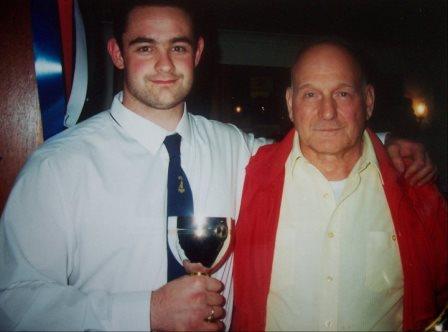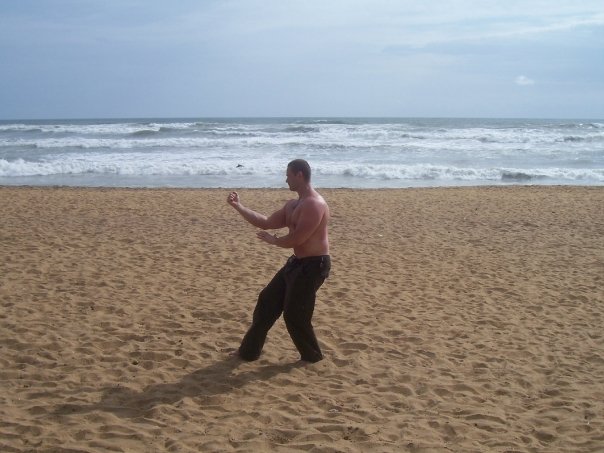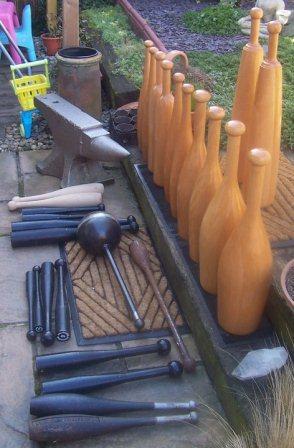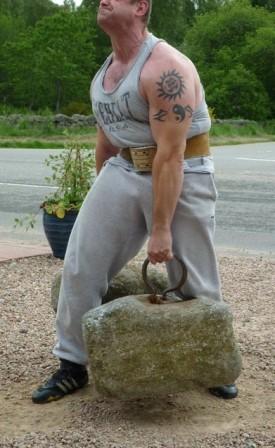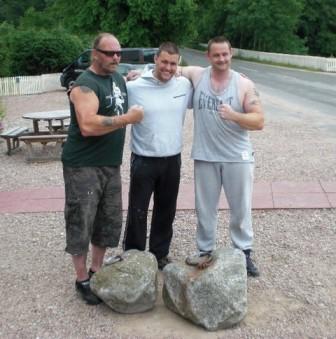Interview and article by Cliff Harvey (www.cliffharvey.com)
Interview – Steve Angell
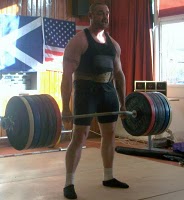
Steve Angell
I faced a crisis back in around 2001…
I had been boxing with the great NZ coach Chris Martin out of the same Auckland Boxing Association stable that included Paula Mataele – at the time the Super Heavyweight Champion of New Zealand. After suffering several concussions during sparring, and having already sustained quite a few playing rugby over the previous 14 years I had been faced with the prospect of giving up my goal of becoming an international fighter. I was pretty despondent about this, and to be honest I needed a new challenge. I had always had a fascination with the seemingly superhuman levels of strength exhibited by people like Arthur Saxon, Herman Goerner, Geoge Hackenshmidt, Joe Greenstein and others. I had also never been truly strong. Sure – I was pretty strong and I threw around some OK weights in the gym – but naturally gifted in strength I certainly wasn’t…
As I researched the old time strongmen and became more and more interested in ‘All Round Weightlifting’, one name stood out, and kept popping up in the competitions of the time as one of the greats of lifting – Steve Angell. The lifts that Steve put up in competitions became the weights that I attempted to meet (pound for pound) and became a focus for me in my early days of strength sports. Years later and having competed in both All-Round and Olympic weightlifting it is my absolute pleasure to now know and be able to ‘shoot the breeze’ with the man that was my inspiration to enter into competition. And it is my pleasure to introduce him to you.
Cliff Harvey – Hi Steve thanks for agreeing to talk with us. It’s a real honour!
Steve Angell – The pleasure’s all mine Cliff, I’m honoured that you feel me worthy of an interview.
CH – Thanks. Steve – I’m sure many of my readers will be aware of your accomplishments, but for the rest can you give us a little bit of your background and history in the iron game?
SA – Well it all started for me in Athletics. I was a hammer thrower who needed to get stronger for the event. I have been Buckinghamshire County Hammer Throwing Champion as a Junior, senior and in 2009 came out of retirement to win the senior championships as a 35-39 year master.
My need to get stronger for throwing led me to train at a great old school type gym in my area. The guy who ran the gym (Brian Clayton) saw the potential in me as a powerlifter and after just over a year of serious training became Junior British Drug Free Powerlifting Champion and I broke the British Deadlift record by 40kgs, recording a lift of 280kgs at 90kgs bodyweight.
The venue for the competition was Steve Gardner’s powerhouse Gym, and there we formed a friendship that would mould my All-round lifting career.
There was a picture on the wall of Steve’s gym of him performing the stone putt in a Highland Games competition. As a thrower this got my juices going, and upon talking to Steve found out he ran strongman and Highland Games competitions. I talked Steve into letting me compete in his next Highland Games competition, and as the youngest guy there, won the games.
As you know Cliff, Steve is one of the main men in the IAWA, and he encouraged me to have a go at an All-Round competition, and the rest as they say is history…
I became a multiple World Champion in the All-Rounds and in the last 20+ years have competed in just about every type of strength sport I could find. A rundown of my achievements are as follows.
County Hammer Throwing Champion
Junior British Powerlifting Champion and record holder
IAWA World Champion 7 times (4 times over-all champion)
IAWA World One Hand Deadlift Champion
WNPF World Deadlift Champion
British Strandpulling Champion 9 times
Britain’s Drug Free Strongest Man Winner 1997
British Deadlift Champion.
Closed the Iron Mind number 3 ‘Captains of Crush Gripper’
Lifted the ‘Dinnie’ stone 9 times (In two visits)
Lifted the ‘Inver’ stone 3 times
CH – That’s quite the wrap sheet Steve! Out of all the things you’ve done what are you most proud of?
SA – The thing I am most proud of, and it was emotionally the hardest thing I have ever had to do was back in September 1996. Just six days before I was due to compete in the World Championships in Glasgow Scotland, My father passed away from cancer. My mother and brothers and sisters wanted me to go to Scotland and compete. It was hard for me to travel to Scotland, but my weightlifting family helped me through it. I won my weight class and best over all lifter award and broke six world records. I then flew back to England and the next day with my brothers and cousin carried my fathers coffin at his funeral. The first time my dad saw me compete, he was shocked how his quiet son could become such an animal. I placed my trophy from my first competition in his coffin. I love and miss my father more than anything…
I am very proud of all of the above as far as winning titles goes. The lift I am most proud of is my 255kgs Zercher. i did this lift at 102kgs bodyweight in 1997, and twelve years later it is still the biggest lift ever done regardless of bodyweight. A lot of the things i am most proud of are what I call ‘off the cuff lifts’, where I did no prior specialist training. They are a 1660lbs Hand & Thigh lift performed in Frank Ciavattone’s basement in Boston USA. We just loaded up the bar to see what I could do. I also Closed an Ironmind No 3 Gripper on site. A guy brought one along to an all-round competition and I closed it. I also Lifted the Dinnie Stones 5 times with no prior training. In fact the lifts were the day after the 2001 IAWA world Championships held in Glasgow Scotland. I had performed 8 lifts over two days and was quite beat up, and after winning my weight class and best lifter award, was a bit worse for ware after celebrating with my Old friend Jack (Daniel’s) on the Sunday night. Never the less, after a 4hr drive to the stones, I lifted them 5 times. I have been back to them since and lifted them a further 4 times.
CH – That’s amazing stuff Steve, and what a great way to honour your father, that must have been terribly difficult. I know that we have agreed before that there is no weight in comp so heavy as that of loved ones coffin. Your family must be incredibly proud…
So Steve I’m interested to hear the story of how you ‘tamed the BEAST’!
SA – That’s one of the hardest off the cuff strength feats I have ever done. Recently I cleaned every rep and pressed a 48kg kettlebell for 100 reps (50 left & 50 right handed) For some reason a 48kg ball with a handle has gotten the name “THE BEAST”. To me that’s just a marketing ploy from Dragondoor, but also it’s setting limitations in peoples mind sets. 100+ years ago, strength Athletes gave us the Dinnie Stones, The inver stone, the Inch Dumbbell and the Apollon Axel. They were “BEASTS” to lift, not a 48kg kettlebell.
CH – Ha ha – that’s great stuff Steve. Too many people put limits on their performance. So talking about limits what are some of your best lifts in competition?
SA – I have always been a platform lifter. By that I mean all my PB’s have been done in competition and not in the gym. My best lifts ever are.
Deadlift 280kgs (90kg bodyweight) 300kgs (110kg bodyweight)
One Hand Deadlift 230kg
Zercher 255kgs
Continental to Belt 250kgs
Continental Clean 182.5 kgs
Continental Snatch 125kgs
Straddle Deadlift 310kgs
Hack Lift 300kgs
Trapbar Deadlift 300kgs
One Hand Snatch 75kgs
Hand & Thigh Lift 1600lbs
I think they are some of my best lifts. Although I did a training phase once doing half front squats out of the power rack and worked up to 800lbs. My coach at the time (Brian Clayton) said it was the best feat of strength he had ever seen drug free.
CH – You were certainly a big inspiration for me when I was first entering into weightlifting competition. who were some of your role models in strength sports?
SA – Thanks Cliff, that means a lot to me. My hero’s if you like were (to start with) Bill Pearl and Bill Kazmaier. I brought a copy of a bodybuilding magazine back in 1986 when I was 16 years old. There was an article about Bill Pearl in it and he was 55 years old at the time. He looked amazing and to this day, i have that magazine at hand to inspire me. Kaz was just a “BEAST” and I loved everything about him. I set out to be the next Kaz. If you see me getting psyched before a lift, it is modelled on Kaz. The two Bill’s are still hero’s of mine.
On the lifting scene a bit closer to home, I have a lot of people to thank for helping me become the best I could be. They include. My first coach Brian Clayton, My hammer throwing coach Jack Kee. My wieghtlifting Coach Chris Gladding, who is a second father to me. Steve Gardner has played a big part in encouraging me during my lifting career.
Just seeing some of my fellow lifters compete has inspired me. Just a few names are – Frank Ciavattone, John Vernacchio, Neil Abery, Howard Prechtel and Denny Haybecker.
Outside the lifting arena, my heroes are Mohammed Ali, English decathlete Daley Thompson and Liverpool football player Kenny Dalglish. And the greatest English Rugby player of all time Martin Johnson.
CH – Well being a Kiwi and rugby fanatic I won’t comment on Martin Johnson mate! But I think we can agree on the rest of the legends you listed.
You are heavily involved in kettlebells now – can you tell us a little about how you became involved with the UKKA?
SA – In 2003 I became the youngest English inductee into the IAWA hall of fame. Steve Gardner put a great evening of entertainment on for the inductee dinner, and one of the the people he booked was Stan Pike, the founder of the UKKA. He did a kettlebell demonstration and i was just instantly hooked. I had seen pictures of kettlebells being used by old time strongmen and just fell in love with them. After the awards ceremony, I chatted to Stan and we hit it off straight away. We were like two old warrior spirits meeting again after a millennium. Steve Gardner got Stan to come back to his gym so we could have a play with the bells and I purchased a 16, 25 and 32kg kettlebell from Stan on that day and spent some time using them to warm up prior to my lifting sessions.
I then contacted Stan about becoming qualified as a UKKA instructor. I travelled up to Scotland a few times over the next year and our friendship grew, as did my kettlebell collection. I now own KB’s from 6kgs through to 56kgs and I truly believe Stan’s ‘IntenseFitness’ kettlebells are the best designed bells in the world.
After my training with Stan, I was proud and honoured to be invited to become a senior Instructor with the UKKA. I now train personal trainers and certify them to become instructors.
I truly think kettlebells are the best training tool out there, but they are not the only tool. I incorporate them into a well balanced strength and conditioning routine. As a strength athlete, I use kettlebells, sand bags, rocks and stones etc to turn the strength I gain from free weight and machine training into functional strength. for instance, I could work up to 150kg seated press on my powertech plate loaded machine and then perform up to 100reps pressing a 48kg kettlebell.
I also love using kettlebells for circuit conditioning training. I perform 5 x two hand swings, 5 x one hand swings each hand, 5 x snatches each hand, 5 x clean and presses each hand, 5 x Fig 8 each direction and 5 x pass around the body each direction. i would warm up with a 16 kg, then work through 20, 25, 32, 40, and 45kg kettlebells.
CH – I’d like to get some ‘from the hip’ opinions from you on “The state of the fitness industry”
SA – It’s full of under qualified instructors. By that I mean under qualified in experience. It’s very easy to qualify as a personal trainer if you have a couple thousand pounds (or dollars) to spend, but I have to be honest, I would not pay most of the people who have come to me to qualify as a KB instructor to train my cat let alone myself. On paper most of the people I have put through their KB instructor courses are more qualified them me, but in a lot of cases they have become clients of mine because they can’t even (or have not been taught on their courses how to) squat correctly. I had one trainer want me to put them through a strength session. I was just ready too beast him because I automatically thought technique would be fine. The first session ended up resulting in me teaching a trainer who had spent around £7,000 on training courses the basic squat techniques.
I gave up on qualification when on my PT instructors course. They (WABBA) said there were only three exercises that trained the hands, wrists and forearms. The reverse curl, wrist curls and wrist roller. I wrote loads of exercises on my written exam amd they failed me. I went mad at the guy running the course. He wrote the answers they required on a piece of paper, handed it to me and said if your paper has these answers on it you will pass. I filled the papaer out, got my qualification – and it is the most worthless piece of paper I own. I think that just about sums up the closed mindedness of the industry as a whole.
CH – “Kettlebells in the industry”
SA – Too many people in it to make a quick buck.
Just about every man and his dog seems to be an expert in KB’s and bringing out very poor DVDs. When i started kettlebell training, bought lots of DVD’s and books trying to gain as much knowledge as possible. How ever most of them seem to be trying to think up new exercises just to bring their next DVD or book out. Just the same as everyone knows that deadlifts, squats, cleans, presses etc are the best compound type exercises to perform using barbells. Swings, snatches, cleans, presses along with some core type exercise like turkish get ups are the best kettlebell exercises to perform to gain the best results. Everything else is just an add on to your training after you have performed the basics.
CH – “Instability devices (bosus etc)”
SA – Deadlift 3 times bodyweight without a belt and you will have all the core stability you will ever need. The picture of you sitting on a bosu ball writing your training diary sums up their worth.
Just stick to basic heavy compound movements, supplemented with kettlebells, sandbags etc and you will get all the core stability you need.
CH – Thanks Steve! We got a lot of use out of that pic!
You know that my speciality is nutrition – what are your philosophies on nutrition? What sorts of things do you eat in a given day?’
SA – I like to work on the KISS theory when it comes to Nutrition. That is ‘Keep It Simple Stupid’.
I keep my nutrition simple and balanced. I like the theory I was taught when I studied the basics of nutrition. “If man has made it or tampered (processed) with it. Limit it or eliminate it from your diet all together.” When I made my mini comeback last year and got my deadlifts over 300kg again, I supplemented with more protein than I had before. On top of my meal plan, I was taking 30 grams of protein in a drink four times a day. I found this very useful in recovering from intense workouts. Other than that, I take a high potency Multi Vitamin, 2 grams of Vit C and B complex Vits daily.
CH – I agree Steve – and I use that analogy (‘if man made it don’t eat it’) a lot in my lectures too.
You have been called a ‘spiritual warrior’ can you tell us a little about the role faith plays in your daily life?
SA – I read a quote in a book once from a Buddhist Monk that kind of sums up my religious faith. He said he loved Christ and Christianity, but was not so keen on ‘churchianity’. That sums me up quite well. I am a very spiritual person, but not mega religious. I believe in and love God, but also believe in the teachings of Buddha. Christ and Buddha are the two most peaceful people to have walked the earth. Once politics has been removed from the teachings of both of them, you come down to the fact that they both just wanted people to live in harmony, help one another and remove greed from their lives. What a great world it would be if that ever happened.
CH – It sure would Steve, great thoughts there. If more people would recognize the fundamental truths of faith and cultivate their own connection with God, ‘The Divine’, ‘The Superconscious’ or whatever you want to refer to it and stop just trying to be ‘right’ the better off the world would be.
So along those lines you’ve also become more heavily involved in yoga and tai chi lately. How did you come to be involved with those?
SA – I had my best ever year lifting in 1997. I was British champion twice, world Champion, did my 255kg Zercher and 230kg One Hand Deadlift and won Britain’s Drug Free Strongest Man competition. However all that obviously took its toll on my body, as in my first Competition of 1998 my back blew out on me. The heavy one hand deadlifts had compressed the lumber discs and to cut a long story short it took two years for me to recover from this injury. Part of my rehabilitation was me purchasing a yoga video for back health. I learnt the exercises on the video and carried on doing them for a few years. Then I took on a client who started telling me about a yoga holiday that she had just come back from run by a guy called Simon Low. My wife had just started getting into yoga at the time and when I told her about Simon Low yoga retreats, she looked him up on the internet and before I knew it had booked us on his next retreat. That was a great retreat and I made a good friend in Simon Low during that week. He admitted to me that when he looked at me as a 240lb weightlifter, he wondered what on earth I was doing on one of his retreats, but I kind of proved to him during that week that you can be very strong, but be flexible as well. With all the meditation, chanting etc we did during the week and me Om-ing with the best of them, I came away from the retreat with the new name, “Peaceful Warrior”. I now have that tattooed on my arm.
I had also become friends with a local Tai Chi teacher by the name of Peter Warr in the early nineties and he taught me a basic routine and some chi gong to help be breath deeper and help with the nerves before competitions. I always know I would take it further at some point. I started going to his classes again a few years ago, and have now done my coaching courses with him and am qualified to teach the Yang style 8, 16 and 24 forms along with the BCCMA 24 form
CH – How have these experiences changed your outlook on training and life?
SA – I have become a more balanced person with yoga and tai chi. Tai chi has taught my the Chinese yin and yang philosophy of hard (strength training) and soft (yoga and tai chi) and that the body works best when they are in balance. I am still very much a yang (hard) man, but try and create as much balance as possible. I also know, I will turn my back on the strength world one day and yoga and tai chi will become the foundation of the remainder of my life.
CH – I’ve certainly found the same Steve. I was introduced to yoga growing up with my Dad and more recently have gotten back into it and I both love it and feel that it for me to provides the ‘yin’ to the ‘yang’ of lifting and fighting.
Looking back over your career how have you evolved as a lifter?…and as a person?
SA – I will be 40 years old in 2010 and I believe I am a better all-round athlete and person than I was in my twenties. That is because I have introduced more conditioning in to my training as well as yoga and tai chi. In my twenties, I was just a beast with the aim of lifting more in each competition.
Looking back, never really enjoyed the moment with all my victories. As soon as the Gold medal was in the bag, I was thinking of the next. My father even said to once that I should sit back and realize what I achieved. It wasn’t until 1997 when my body could not take anymore beatings and subsequently I had to take two years out to rehab my back and body that I started bringing more balance it to my training. In 2001 / 2002, I had lost that balance again and despite being the strongest I had ever been, I took it too far again and completely detached my right distal biceps tendon. I had to have surgery to reattach it and another year to fully recover from the injury. It was then that I took a step back and could see what I was doing to myself and my wife and family. I retired from International competition in 2002 and that is is when I added boxing training into my routine and then the following year met Stan Pike and was introduced to kettlebells. From there my training has become much more balanced. I always felt I was only six months real hard training away from being able to hit big poundage’s again though. And this was proved right in 2009 when I competed in my County Championships at Hammer throwing after a break of 13 years and won the Gold Medal and then after 10 weeks heavy training broke the IAWA Trap -Bar Deadlift World Record pulling my first 300kg deadlift since 2002.
CH – What are you working on right now Steve? Any new projects on the way?
SA – 2009 was a bit of a comeback year for me winning the County Hammer throwing championships and deadlifting 300kgs again. The real inspiration behind this was my daughter Ella. I wanted to win medals and trophies for her, so she would know her daddy was at one time one of the strongest drug free people in the world. She really is my inspiration now. And also I have to stay big and strong to keep the boys at bay when she gets older Ha Ha.As I stated earlier, I will be 40 in 2010 and I wanted to do something mad to celebrate my 40 years on the planet. I am sharing this goal with you exclusively in the interview. As you know I have a love for stone lifting and the most famous stones in the world are the Dinnie stones in the highlands of Scotland. I have visited them twice, lifting them 5 times in 2001 and four times in 2007. For my 40th I am going to attempt to lift them 40 times. This is the biggest (and craziest) goal I have ever set myself. In the fourth rep back in 2007, I tore the skin from my hand and was unable to attempt any more reps, so I am going through some very strict training for this goal and am videoing my training and the attempt its self and if successful will be bringing a DVD out of the whole thing. As you say Cliff, “if you shoot for the stars and reach the moon, you have still had a great journey”. With this goal I am shooting for the stars and am very much looking forward to the journey.
CH – Wow Steve, that is one hell of a goal! Thanks for sharing it with me and my readers. If there’s anyone who can do it, it’s you mate.
Thanks again for taking time out of your busy schedule to talk to me mate. It’s an honour and a pleasure to be ‘singing from the same song sheet’ as you would say.
(Webmaster’s comment: I want to again thank Cliff for allowing The Daily News to run his interview with Steve Angell. This interview is also available on Cliff’s website and blog – which can be found at www.cliffharvey.com.)
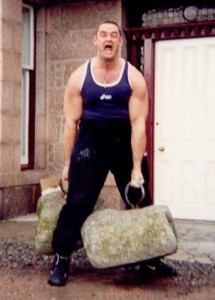
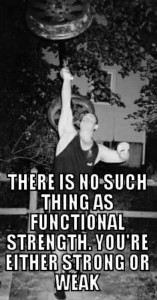 For a 70/70 (wt. class/age group!) guy like myself, with each thigh smaller than one of Steve Angell’s huge arms, I’m not about to search for a 440 pound kettlebell just to START progression as Steve would enjoy doing! But his comments did get me thinking of new off-day, or “active rest,” heavy exercise apart from normal all-round workouts. Somewhere around the house, I reasoned, were a few various kettlebells, which I always considered to be just glorified “HANDLES with weight,” probably being used as doorstops. However, with sufficient numbers and strengths of rubber flex bands inserted through that ample handle space it would be simple to build almost any variable resistance that anyone could care for in an exercise! So, derived from a past practice of placing bands over barbells to create a heavier pressure, continuous tension lift, I developed my new experimental combo – “KETTLEBANDS”!
For a 70/70 (wt. class/age group!) guy like myself, with each thigh smaller than one of Steve Angell’s huge arms, I’m not about to search for a 440 pound kettlebell just to START progression as Steve would enjoy doing! But his comments did get me thinking of new off-day, or “active rest,” heavy exercise apart from normal all-round workouts. Somewhere around the house, I reasoned, were a few various kettlebells, which I always considered to be just glorified “HANDLES with weight,” probably being used as doorstops. However, with sufficient numbers and strengths of rubber flex bands inserted through that ample handle space it would be simple to build almost any variable resistance that anyone could care for in an exercise! So, derived from a past practice of placing bands over barbells to create a heavier pressure, continuous tension lift, I developed my new experimental combo – “KETTLEBANDS”!